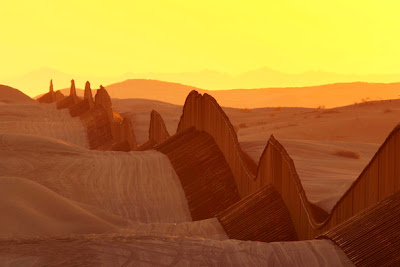 The elegant abstraction of this picture belies the controversy surrounding the expansion of the U.S.-Mexico border fence on previously pristine desert sand between Yuma, Arizona and Calexico, California. This in a Homeland Security effort to ward off the escalating violence of Mexican drug cartels. The picture is part of a photo essay by David McNew, which details the story.
The elegant abstraction of this picture belies the controversy surrounding the expansion of the U.S.-Mexico border fence on previously pristine desert sand between Yuma, Arizona and Calexico, California. This in a Homeland Security effort to ward off the escalating violence of Mexican drug cartels. The picture is part of a photo essay by David McNew, which details the story.The fence's primarily purpose is to contain illegal immigration -- cartels but mostly individuals in search of a better life, as captured in the documentary Crossing Arizona. A contentious issue in local and national politics. French politician Michel Rocard once said hat France cannot absorb all the world's misery. The same goes for the U.S., yet could the country's economy survive without the cheap labor provided by illegal immigrants? States like California, especially?
What if all the Mexican and other Latino illegals stopped coming? What would happen to cities like L.A., so reliant on Latino nannies, gardeners, and other busboys? How about local farming? How could we afford cheap California grapes without illegal hands laboring in the sun 10-12 hours a day for as little as $3 an hour, as reported in this poignant LA Times story? Even American Apparel, which built its reputation on manufacturing locally, was busted recently for employing illegals -- reportedly one third of its workforce.
Most are still better off than at home, turning their exploitation into some kind of sick arrangement. Could our richer societies afford to incorporate them as equals, with equal pay and equal rights? Would it increase the problem, by attracting even more immigrants? Where do you draw the line? Tough call, no easy answer.
Immigration works like osmosis: as long as discrepancies between rich and poor will be so blatant, the poor will keep migrating towards the rich. No border fence will stop them. Nor the drug gangs.
photo David McNew/Getty Images North America

No comments:
Post a Comment